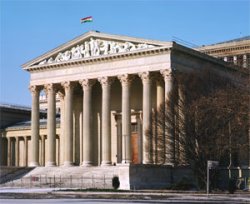 |
 |
 |
 |
 |
| magyar | English | deutsch | italiano | espańol |
Museum of Fine Arts
Budapest City Guide:
Budapest Public Transportation
Metro Lines of Budapest
Weather in Budapest
Central Market Hall
St. Stephen's Basilica
Gellert Thermal Bath and Swimming Pool
Gellért Hill
Budapest baths
Hungarian National Opera
Museum of Fine Arts
Gallery of Arts
Museums and galleries
Heroes' Square
Budapest Zoo and Botanical Garden
Budapest Amusement Park
City Park Skating Rink
Margaret Island
The Citadella
Sziget Festival
Ráday street
Puskás Ferenc Stadium
Botanical Garden
Budapest Card
Confectioners in Budapest
City structure of Budapest
Ferihegy 1 Airport
Ferihegy 2 Airport
Airline Companies at Ferihegy
Parking in Budapest
Public Toilets
Distances from Budapest
New Year's Eve in Budapest
Air Pollution in Budapest
Pickpockets in Budapest
Homeless People in Budapest
Changing Money in Budapest
Ships in Budapest
West End City Center
Market customs
The Danube in Budapest
Hungary Tourist Guide
| Hotel Booking |
| Hungarian cities |
| Programs |
| Car Rental |
| Weather |
 The Museum of Fine Arts Budapest is regarded as one of Europe's most significant institutions. The versatility of its permanent exhibitions, its historical continuity, and the wide array of masterpieces has made it a truly unique establishment. The museum is home to universal artifacts from ancient times to today. They also offer a number of unique programs, guided tours, and a jazz salon.
The Museum of Fine Arts Budapest is regarded as one of Europe's most significant institutions. The versatility of its permanent exhibitions, its historical continuity, and the wide array of masterpieces has made it a truly unique establishment. The museum is home to universal artifacts from ancient times to today. They also offer a number of unique programs, guided tours, and a jazz salon.Transportation: The Museum of Fine Arts Budapest is located in the XIV. district near Hősök Tere (Heroes Square), across from the Gallery (Műcsarnok). It is easily accessible via public transport by taking the millennium underground (M1, yellow metro line), the trolley busses 72, 75, 79, or by buses 4, 20, or 30.
History: Construction of the museum was commissioned by the millennium act of 1896. Instead of establishing a new collection, its goal was to unite existing collections under one roof. The Museum of Fine Arts inaugural ceremony was held on December 1st, 1906 and attended by I. Franz Joseph. It was opened to the public on December 5th.
Initially the museum did not own any of the art treasures that the aristocracy had accumulated over the years. The reform era was a turning point - members of the nobility began to donate items from their personal collections. Count Ferenc Széchényi started the trend in 1802 when he donated his large collection of books, crests, and coins to the future National Museum. As part of the his collection, there were a few paintings and portraits which served not only to broaden the National Museum's gallery, but also established the basis for the Museum of Fine Arts 100 years before its birth.
Many followed Széchényi's example, although the next major expansion to the National Museum's gallery didn't come until the 30's, when two more private catalogs were donated. This was when Miklós Jankovich, one of Pest's most famous art collectors of the time, contributed his collection of valuable paintings and sculptures and László János Pyrker, archbishop of Eger, donated more than 200 paintings.
Perhaps the most important addition to the Museum of Fine Arts' collection was the National Gallery. This was basically made up of the Esterházy family's massive collection - Pál Esterházy sold his entire collection of more than 600 paintings, 3500 drawings, and 51000 graphics reproductions to the Hungarian state in 1865. The collection included such gems as Raffaello's Madonna and his self-portrait, in addition to Correggio's "Breast feeding Madonna".
In 1875 the fine arts from the National Museum were transferred to the National Gallery, which provided the basis for the Museum of Fine Arts. Károly Pulszky led the gallery until the turn of the century - this era was marked with significant expansion and the establishment of the Sculpture Collection with more than one hundred, mainly Italian statues. Pulszky helped draft the bill that eventually led to the establishment of the new Museum of Fine Arts.
1912 marked the final episode in the line of expansion by noble collections. This time it was the Pállfy family's contribution, which was the largest expansion to the gallery since the Esterházy sale. After this, it was mainly affluent citizens who donated - as did Pál Majovszky with his valuable, modern, primarily French drawing collection.
Thanks to the hard work of Elek Petrovics, the interwar period was another lucrative time for the museum. They bought István Ferenczy's precious bronze collection and it was during these years that the Modern Collection was founded.
Many priceless items were stolen and the building was heavily damaged during World War II. Fortunately, most of the objects were recovered by 1947 and following their restoration and the building's repair the gallery reopened in 1949.
The continuous expansion eventually led to the establishment of a separate Hungarian National Gallery in 1957. This institution focuses on Hungarian arts while the Museum of Fine Arts is more universal.
Collections:
Building: In 1898, a tender was called for planning the new Museum of Fine Arts: Albert Schickedanz and Fülöp Hezog's design was accepted. Built from 1900 to 1906, the neo-renaissance gallery was first, followed by the classical entrance hall. A replica of the Statue of Zeus at Olympia can be found in the tympana above the eight-pillar entrance. Inside, one will find separate doric, ionic, roman, renaissance, and baroque hall for the statues of each era. The building also houses a cloakroom, coffee shop, souvenir shop, and public library.
E-mail:

Fax: +36 1 900 9079
All rights reserved.